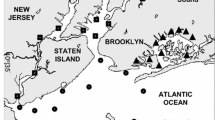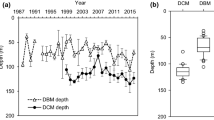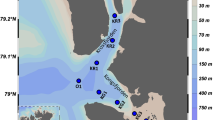Abstract
Accelerating eutrophication manifest as increasing frequency and magnitude of phytoplankton blooms threatens living resources in many estuaries. Effects of large blooms can be difficult to document because blooms are often unexpected and do not always coincide with scheduled sampling programs. Here we use continuously monitored salinity distributions and optical properties to study the spring bloom of the red tide dinoflagellate,Prorocentrumminimum, in the Rhode River, Maryland, a tributary embayment of upper Chesapeake Bay. Salinity distributions, together with weekly cruise measurements of nutrient concentrations, indicate that the bloom commenced with an influx of nitrate at the mouth due to the arrival of a freshet from the Susquehanna River. Arrival of this freshet at the mouth set up an unstable, inverse salinity gradient within the Rhode River. Continuously monitored absorption and scattering spectra indicated that increases in chlorophyll within the Rhode River initially were due to the influx of chlorophyll that had developed in the main stem of the bay. After the influx, much higher concentrations and steep spatial gradients developed within the Rhode River, subsequent to reduced mixing that accompanied re-establishment of a normal estuarine salinity gradient. We used the monitored absorption and scattering coefficients to determine the effect of the bloom on light attenuation coefficients in the Rhode River. The bloom resulted in a nearly three-fold increase in attenuation coefficient. Attenuation was dominated by chlorophyll in the early stages of the bloom and by detritus after the termination of the bloom. Although the bloom lasted only 20 d, the elevated attenuation coefficients due to the bloom exceeded values that would permit growth of submersed vascular plants for a period of about 45 d.
Similar content being viewed by others
Literature Cited
Carter, V., N. B. Rybicki, J. M. Landwehr, andM. Naylor 2000. Light requirements for SAV survival and growth, p. 4–15. In R. A. Batiuk, P. Bergstrom, W. M. Kemp, E. W. Koch, L. Murray, J. C. Stevenson, R. Bartleson, V. Carter, N. B. Rybicki, J. M. Landwehr, C. L. Gallegos, L. Karrh, M. Naylor, D. J. Wilcox, K. A. Moore, S. Ailstock, and M. Teichberg (eds.). Chesapeake Bay Submerged Aquatic Vegetation Water Quality and Habitat-based Requirements and Restoration Targets: A Second Technical Synthesis. U.S. Environmental Protection Agency, Chesapeake Bay Program, Annapolis, Maryland.
Chang, G. C. andT. D. Dickey. 1999. Partitioning in situ total spectral absorption by use of moored spectral absorption-attenuation meters.Applied Optics 38:3876–3887.
Dickey, T., D. Frye, H. Jannasch, E. Boyle, D. Manov, D. Sigurdson, J. McNeil, M. Stramska, A. Michaels, N. Nelson, D. Siegel, G. Chang, J. Wu andA. Knap. 1998. Initial results from the Bermuda testbed mooring program.Deep-Sea Research 145:771–794.
Gallegos, C. L. 1992. Photosynthesis, productivity, and species composition in a eutrophic sub-estuary: Comparison of bloom and non-bloom assemblages.Marine Ecology Progress Series 81:257–267.
Gallegos, C. L. 1994. Refining habitat requirements of submersed aquatic vegetation: Role of optical models.Estuaries 17:198–219.
Gallegos, C. L. 2001. Calculating optical water quality targets to restore and protect submersed aquatic vegetation: Overcoming problems in partitioning the diffuse attenuation coefficient for photosynthetically active radiation.Estuaries 24:381–397.
Gallegos, C. L., D. L. Correll, andJ. W. Pierce. 1990. Modeling spectral diffuse attenuation, absorption, and scattering coefficients in a turbid estuary.Limnology and Oceanography 35: 1486–1502.
Gallegos, C. L. andT. E. Jordan. 1997. Seasonal progression of factors limiting phytoplankton pigment biomass in the Rhode River estuary, Maryland (USA). II. Modeling N versus P limitation.Marine Ecology Progress Series 161:199–212.
Gallegos, C. L., T. E. Jordan, andD. L. Correll. 1992. Eventscale response of phytoplankton to watershed inputs in a subestuary: Timing, magnitude, and location of phytoplankton blooms.Limnology and Oceanography 37:813–828.
Gallegos, C. L. andP. J. Neale. 2002. Partitioning spectral absorption in case 2 waters: Discrimination of dissolved and particulate components.Applied Optics 41:4220–4233.
Han, G. C. 1974. Salt balance and exchange in the Rhode River, a tributary embayment to the Chesapeake Bay. Ph.D. Dissertation, The Johns Hopkins University, Baltimore, Maryland.
Harding, L. W. J. andD. W. Coats, 1988. Photosynthetic physiology of the dinoflagellate,Prorocentrum mariae-lebouriae, during its subpycnocline transport in Chesapeake Bay.Journal of Phycology 24:77–89.
Huslin, A. 2001. Bay grasses slow to gain, report says. Washington Post. May 24, 2001.
Hyland, T. 2001. Bay grasses slipping in area rivers. The Capital Online, May 24, 2001.
Jeffrey, S. W. andG. F. Humphrey. 1975. New spectrophotometric equations for determining chlorophyll,a, b, c1, andc2 in higher plants, algae and natural phytoplankton.Biochemie und Physiologie der Pflanzen 167:191–194.
Jordan, T. E., D. L. Correll, J. Miklas, andD. E. Weller. 1991a. Nutrients and chlorophyll at the interface of a watershed and an estuary.Limnology and Oceanography 36:251–267.
Jordan, T. E., D. L. Correll, J. Miklas, andD. E. Weller. 1991b. Long-term trends in estuarine nutrients and chlorophyll, and short-term effects of variation in watershed discharge.Marine Ecology Progress Series 75:121–132.
Kelly, M. G., G. M. Hornberger, andB. J. Cosby. 1974. Continuous automated measurement of rates of photosynthesis and respiration in an undisturbed river community.Limnology and Oceanography 19:305–312.
Kirk, J. T. O. 1984. Dependence of relationship between apparent and inherent optical properties of water on solar altitude.Limnology and Oceanography 29:350–356.
Kirk, J. T. O. 1992. Monte Carlo modeling of the performance of a reflective tube absorption meter.Applied Optics 31:6463–6468.
Kirk, J. T. O. 1994. Light and photosynthesis in aquatic ecosystems, 2nd edition. Cambridge University Press, Cambridge, U.K.
Koch, E. W. 2001. Beyond light: Physical, geological, and geochemical parameters as possible submersed aquatic vegetation habitat requirements.Estuaries 24:1–17.
Malone, T. C., D. J. Conley, T. R. Fisher, P. M. Glibert, L. W. Harding, andK. G. Sellner. 1996. Scales of nutrient-limited phytoplankton productivity in Chesapeake Bay.Estuaries 19:371–385.
Moore, K. A., R. L. Wetzel, andR. J. Orth. 1997. Seasonal pulses of turbidity and their relations to eelgrass (Zostera marina L.) survival in an estuary.Journal of Experimental Marine Biology and Ecology 215:115–134.
Orth, R. J. 1992. Chesapeake Bay SAV restoration targets, p. 109–136.In R. A. Batiuk, R. J. Orth, K. A. Moore, W. C. Denison, J. C. Stevenson, L. Staver, V. Carter, N. Rybicki, R. E. Hickman, S. Kollar, S. Bieber, P. Heasley, and P. Bergstrom (eds.) Submerged Aquatic Vegetation Habitat Requirements and Restoration Targets: A Technical Synthesis. Chesapeake Bay Program, U.S. Environmental Protection Agency. Annapolis, Maryland.
Preisendorfer, R. W. 1976. Hydrologic Optics. National Oceanic and Atmospheric Administration, Washington, D.C.
Richardson, K. andB. B. Jorgensen. 1996. Eutrophication: Definition, history and effects, p. 1–19.In B. B. Jorgensen and K. R. Richardson (eds.). Eutrophication in Coastal Marine Ecosystems. American Geophysical Union, Washington, D.C.
Sathyendranath, S. andT. Platt. 1997. Analytic model of ocean color.Applied Optics 36:2620–2629.
Schubel, J. R. andD. W. Pritchard. 1986. Responses of upper Chesapeake Bay to variations in discharge of the Susquehanna River.Estuaries 9:236–249.
Smayda, T. J. 1990. Novel and nuissance phytoplankton blooms in the sea: Evidence for a global epidemic, p. 20–40.In E. Granéli, B. Sunderström, L. Edler, and D. M. Anderson (eds.). Toxic Marine Phytoplankton. Elsevier, New York.
Tyler, M. A. andH. H. Seliger. 1978. Annual subsurface transport of a red tide dinoflagellate to its bloom area: Water circulation patterns and organism distributions in the Chesapeake Bay.Limnology and Oceanography 23:227–246.
Author information
Authors and Affiliations
Corresponding author
Rights and permissions
About this article
Cite this article
Gallegos, C.L., Jordan, T.E. Impact of the Spring 2000 phytoplankton bloom in Chesapeake Bay on optical properties and light penetration in the Rhode River, Maryland. Estuaries 25, 508–518 (2002). https://doi.org/10.1007/BF02804886
Received:
Accepted:
Issue Date:
DOI: https://doi.org/10.1007/BF02804886




